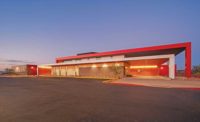Operation Allies Welcome
Alamogordo, N.M.
BEST PROJECT, GOVERNMENT/PUBLIC BUILDING
Submitted By: Fluor
Owner: U.S. Air Force
Lead Design Firm/General Contractor: Fluor
Civil Engineer: U.S. Air Force Civil Engineer Center
Structural/MEP Engineer: Mahaffey Tent & Awning Co.
MEP Engineer: Tempe Mechanical
In just 15 months, Fluor built a temporary processing village to house and support a total of 7,219 guests as part of this $352-million Operation Allies Welcome (OAW) project, which served a critical humanitarian mission and fulfilled America’s commitment to grant asylum to Afghan Special Immigrant Visa applicants and other vulnerable Afghan allies. Completed on budget and ahead of schedule in November 2022, the project included 87 temporary tent structures erected across more than 13 acres, along with utilities on a site lacking any existing infrastructure.
Given the tight timeline and urgent mission requirements, Fluor quickly subcontracted with a local small business labor provider to augment its construction workforce. The team managed 25 subcontractors to support equipment mobilization, transportation, village support, pest control, fencing and life support services.
Close collaboration between the contractor and the project’s subcontractors on value-added changes to the original construction plan helped improve site layout, safety and functionality throughout construction.

Photo courtesy FLUOR
Although the government didn’t provide drawings or a site layout, the Air Force Civil Engineers helped the contractor prepare the site. Fluor’s 24/7 operations center helped create facility layout maps of the village and expansion areas, updating the maps as the government added new facilities and functions to the existing infrastructure.
The team made daily adjustments to the camp layout and worked continuously with subcontractors and government representatives to determine the placement of tents and facilities. Fluor also relied on its subcontractors’ experience mobilizing assets, constructing tent facilities and connecting power and HVAC to accelerate the timeline.
With rapidly fluctuating government requirements, the contractor implemented a rough order of magnitude (ROM) process rather than a full project planning estimate. This helped cut the decision process to hours or days rather than weeks. Fluor submitted more than 30 ROMs for the government to review.

Photo courtesy FLUOR
With such a high population of Afghan guests in a constrained environment, safety concerns arose for families and children living and playing near the power generation, electrical and HVAC equipment and construction machinery. The construction team quickly repurposed existing fencing for the camp perimeter to prevent access to dangerous areas during and after construction. In addition to fencing HVAC, electrical, sewage and water nodes, crews also created multilingual signage to ensure guest safety.
Fluor’s team also leveraged its 12 years of experience working in Afghanistan to ensure compliance with Afghan cultural sensitivities, incorporating separate recreation, classroom, housing, bathroom, dining and worship facilities for men and women into the village design. Crews installed a 9,600-sq-ft multipurpose tent, facilities and facility support for religious-use-designated tents and three multipurpose tents for indoor NGO-led activities, non-vocational education classrooms and assembly space.




